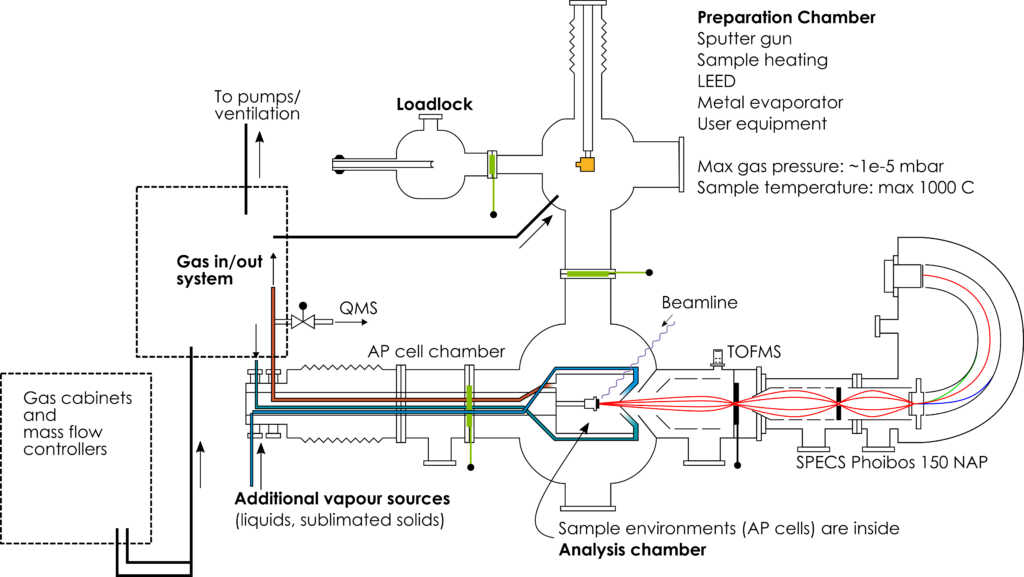General information
| SR beam spot size | 100 µm x 100 µm |
| Pressure range for XPS measurements | UHV to 20 mbar |
| Analyser | SPECS Phoibos 150 NAP |
| Energy range | 30 to 1500 eV |
The SPECIES APXPS endstation is designed for ambient-pressure XPS measurements using dedicated cells. The endstation is equipped with UHV manipulator to facilitate normal measurements in UHV conditions with sample heating and some sample preparation methods. Dedicated ambient pressure cells enable measurements to be carried out at higher gas pressures. Below we describe the endstation in detail.

X-ray transmission through different windows

Approximate flux inside the AP cell (using Al window)


Analysis chamber
| Base pressure | 5e-10 mbar |
| Sample manipulation | X, Y, Z, rot (UHV manipulator X, Y, Z (AP cells) |
| X-ray sources | EPU61, 1.5 GeV ring and SPECS XR50 with Mg and Al anodes, 250 W power (not monochromatized and unfocused) |
| Sample storage | Garage with 3 sample slots |
Ambient Pressure XPS
| Max pressure | 20 mbar |
| Max temperature | Standard cell: Up to ~600 C with resistive heating (Graphite heater disk under the sample). Maximum temperature is environment (gas) dependent ALD cell: Up to ~400 C with resistive heating (button heater with Pt filament) |
| Min temperature | Room temperature. |
| SR incidence angle | 57 deg with respect to electron analyser |
| SR window material | Al, 200 nm (default) Si3N4, 200 nm (upon request) Zr, 200 nm (upon request) |
| Electron detection angle | Normal to surface |
| Analyser apertures (with AP cells) | 0.3 mm (default) 0.5 mm 1.0 mm |
| Mass specs | Gas inlet/outlet: Pfeiffer QMS 250 M2, PrismaPro up to 200 amu range Prelense: VACOM NOVION TOFMS up to 200 amu |
| Gas dosing | Using MFCs or leak-valves. Standard cell: Current status: Up to two independent (hazardous) gases Under construction/validation: Two gas mixing panels for a total of 8 gases. ALD cell: Two precursors with their independent gas lines. Possibility for additional gases upon request. |
| Standard cell | Available for users |
| Sulphur cell | Cell under commissioning/construction. Gas system under construction ALD cell |
| ALD cell | Available for users. |
UHV XPS
| Max pressure | 1e-5 mbar (backfilling mode) |
| Min pressure | 2e-10 mbar |
| Max temperature | Up to ~1000 C with e-beam heating (PID control) |
| SR incidence angle | 55 deg with respect to analyzer |
| Electron emission angle | Variable |
Analyser
| Type | SPECS Phoibos 150 NAP with differentially pumped lens system |
| Energy resolution | < 10 meV, depending on applied settings |
| Kinetic energy range | 0 to 3.5 keV |
| Detector | Delay line detector (Surface Concept). |
| Modes | Transmission (medium and small area), angular |
| Software | SpecsLab Prodigy |
Preparation chamber
| Base pressure | 2e-10 mbar |
| UHV manipulator | X, Y, Z and polar rotation |
| Heating | Up to ~1000 C with e-beam heating (PID or manual control) |
| Cooling | Air cooling of sample stage |
| Sputter gun | SPECS Ar Sputter gun |
| LEED | SPECS ErLEED |
| Evaporation source | Focus EFM 3T triple cell evaporator |
| Gases | Possible to dose up to 5e-5 mbar using a leak-valve |
| Electrospray | Available upon special request |
| Available ports for user equipment | Port size DN40CF with a manual gate valve (no need of venting preparation chamber for installation) |
Load-lock
| Base pressure | 2e-8 mbar |
| Sample holder | Flag style (see below) |
| Sample size | Approximately 8 mm x 8 mm (see image below) |
| Transfer time | 30 min (from air) |
| Vacuum suitcase | Portable vacuum suitcase (e.g. from STM lab) can be installed in place of the transfer arm. |
| Available ports (atmospheric suitcase) | Portable atmospheric suitcase with 8 sample slots. It can be taken to chemistry lab glove box and filled with inert gas. |
SPECIES uses flag style samples with a modified thermocouple design. Users can request to have sample holders shipped to them in advance. Sample holder is compatible with the design at HIPPIE beamline (Samples from HIPPIE can be taken to Species, but not vice versa).
The sample plates contain an on-board K-type thermocouple which allows for sample temperature measurements. The thermocouple junction can be spotwelded on the plate, or anywhere else depending upon user needs.

Additional equipment
List of additional equipment available at the SPECIES-APXPS endstation. Please ask the beamline staff for further information
- Solar simulator (Assahi Spectra HAL-320W) with a customized light guide. Typically attached to a CF40 flange on the endstation so that light can be used in either UHV manipulator or inside the AP cell. Use of solar simulator requires that the X-ray anode is removed.
- Xenon flash lamp (Hamamatsu L6605, 60W). Pulsed lamp with variable repetition rate (10-100 Hz) and variable intensity. Typically attached directly to a fused silica CF40 flange on the endstation. Use of the UV lamp requires that the X-ray anode is removed.
- Ozone generator: Triogen LAB2B generator. The generator is mobile and can be easily attached to different gas setups.